AI in Sales: Maximizing Efficiency and Closing the Deal

Whether you are a lead generator, sales rep, or sales manager in charge of a team of sales reps, you'll be familiar with certain daily challenges in sales.
The administrative tasks, the extensive research that may or may not lead to results, the never-ending flow of sales calls, emails, and follow-ups, and the frustratingly slow responses.
All taking up valuable time that could otherwise be spent guiding more qualified prospects through the sales funnel.
The good news is, artificial intelligence, particularly generative AI tools like ChatGPT, now offers a solution by automating these routine pain points for sales reps. But the effectiveness of generative AI greatly depends on if you use the tools correctly.
One of the greatest perks of using generative AI tools like ChatGPT is its ability to tackle complex strings of prompts to achieve what you're aiming for. A few people have really mastered the art of these prompt threads and have shared their inputs.
Let's take a look at their stories and hopefully gain some insights that can be adapted to your workflow, regardless of the industry you're in.
Generating Cold Emails
Sales and lead generator coach Patrick Dang says that one of the best methods for getting a prospect on the phone these days is sending a cold email first. And it's undoubtedly one of those pesky tasks that take up a majority of a sales rep's day.
Dang says that using ChatGPT in combination with emailing software like Hunter.io or Mailchimp can help speed up the cold emailing process.
The first step is finding the companies that you want to reach out to. For his example, he used the instance of a freelancer selling digital marketing services and wanted to target HR SAAS companies. So his first prompt to ChatGPT was;
"[Find the] top HR companies in the USA and provide a link to their website"
And of course, depending on your product or service, you could modify the question, but the idea is to get a list with the websites. Because his next step was to take the domain of the companies that ChatGPT has generated and enter it into Hunter.io to get a list of emails of people that work at that company.
He filters through to find the people that he wants to send the email to, in his case, the director of marketing and maybe the head of HR.
Now that he has the emails, he goes back to ChatGPT to write the subject line and the content body for the email that he wants to send;
"Create 5 variations of this subject line: Generate More Leads with Content Marketing"
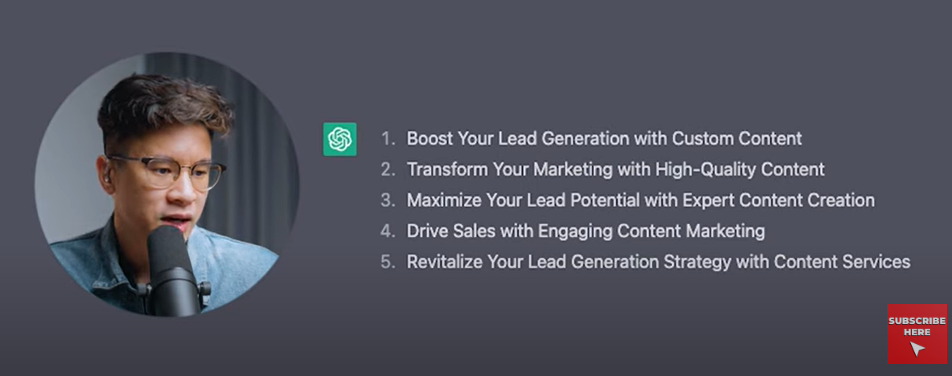
I like that he has asked for 5 options here because I've also found that asking for a few options helps get a response that I like the first go around without having to keep asking "Give me another option." Now for the body of the email;
"[W]rite me a cold email to the marketing team at Mercer about how I can help them generate more leads with content marketing I will help them create high-value written content for the audio buyers which will lead them to sign up for lead magnets I will help them convert the leads into sales mentioned that my past clients include Oracle workday and ADP in the end include a call to action telling them to book a schedule on my time on my calendar if it makes sense to work together."
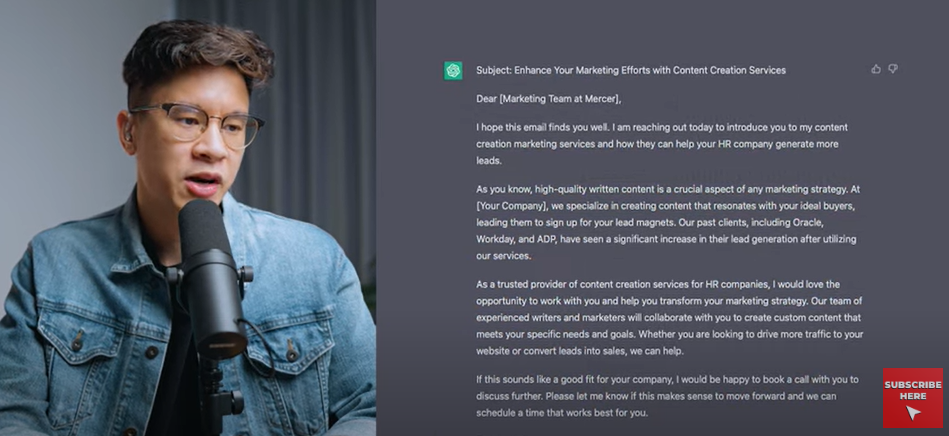
Which he again enters into his email software, and goes back to ChatGPT for a follow-up;
"Write me an email assuming the prospect does not respond."
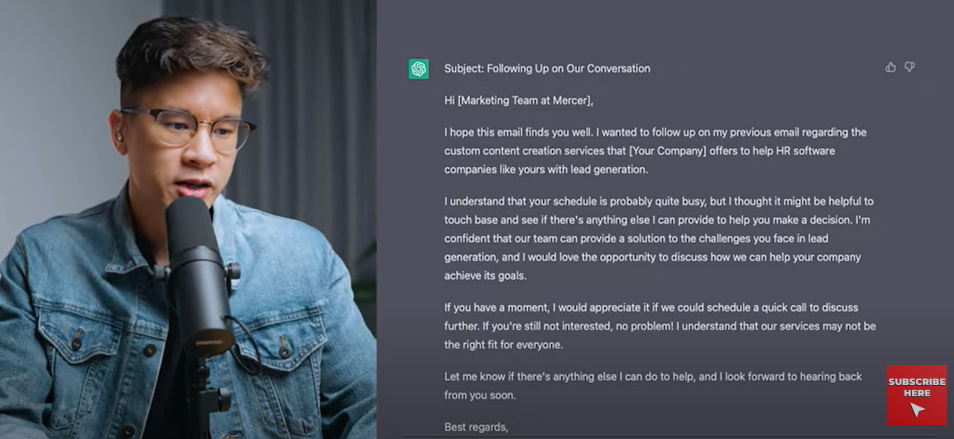
The response from ChatGPT was too long for his liking so he followed up with;
"Rewrite it. Make it only 3 sentences long."
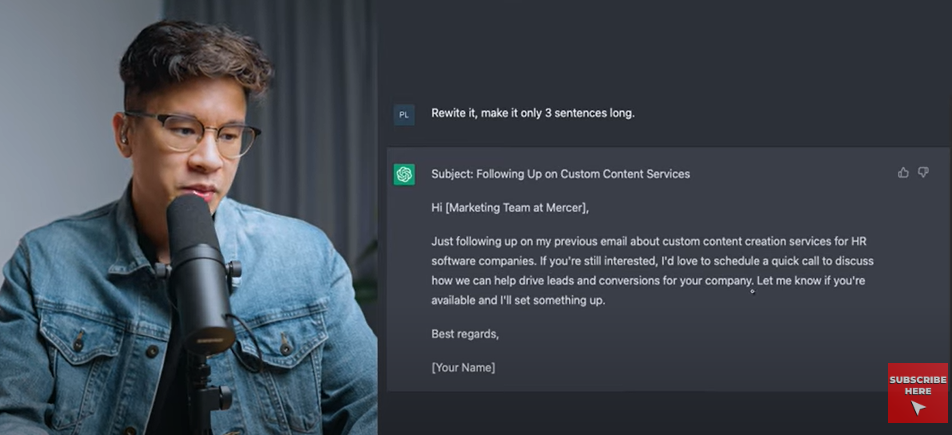
Overall, he gave ChatGPT credit for getting him about 60-70% of the way there, and he would have to adjust the rest, but time-saving nonetheless. He went on to generate 3 different versions of the email and plugged it into the email software for various automatic follow-ups.
So, as we can see from this example, ChatGPT is conversational. You can go back and forth with it if you don't like the output to get a modified response. But that said, if you can master the input prompt on the first go around, there won't be as much need for the back and forth. In the example above, if Dang would have asked ChatGPT to "write an email assuming the prospect does not respond. Make it 3 sentences long," he likely would've gotten his desired outcome the first time around.
Closing the Deal
Jake Dunlap, CEO of Skaled Consulting, claims to have discovered the perfect ChatGPT prompt series to help sales reps close more deals. After multiple trials and errors, he believes sales reps in any industry (which seems to be most likely geared toward B2B sales) can run through this series of prompts, and be ready to give a pitch that will seal the deal.
While he shared the fine-tuned list of prompts, Dunlap didn't post the outputs, so I decided to put it to the test myself. His target prospects, since he sells sales consulting services, are the VPs of sales, and in his model, he uses the tech industry. So for the purpose of this example, let's use his information.
Prompt 1: "I sell a product that you can find at (domain) and we have 4 main value propositions(Insert 4 value props). What do (Job title) care about most in the (sub-industry) assuming that the economy is not great or may go down"
My prompt was: "I sell a product that you can find at https://skaled.com/ and we have 4 main value propositions; Sales Performance Improvement, Sales Process Optimization, Sales Training and Coaching, and Sales Strategy Development. What do VPs of sales care about most in the tech industry assuming that the economy is not great or may go down?"
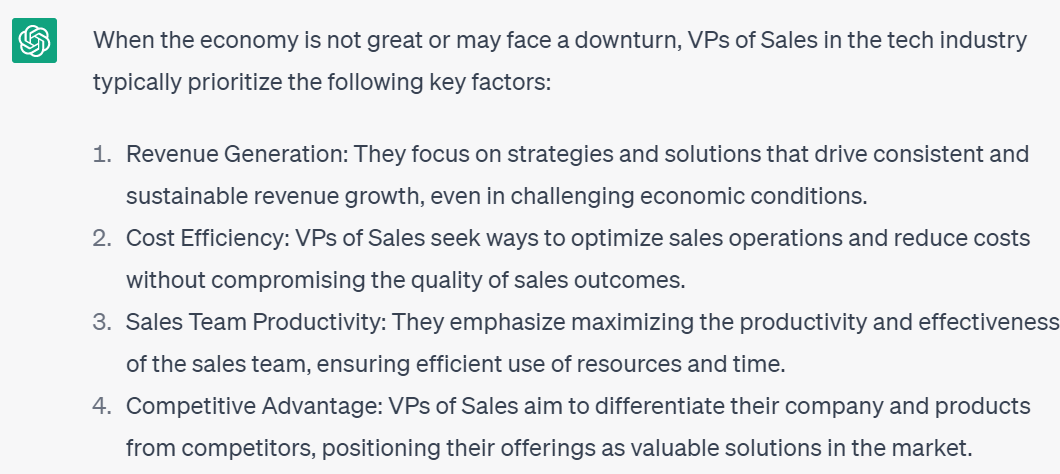
I'm not sure if the information at the beginning of the prompt contributed to the output at all, or if we could've jumped right into "what do VPs of sales care about.." but maybe they will later on. Now on to Dunlap's second prompt;
Prompt 2: "What do they NOT care about in these environments?"
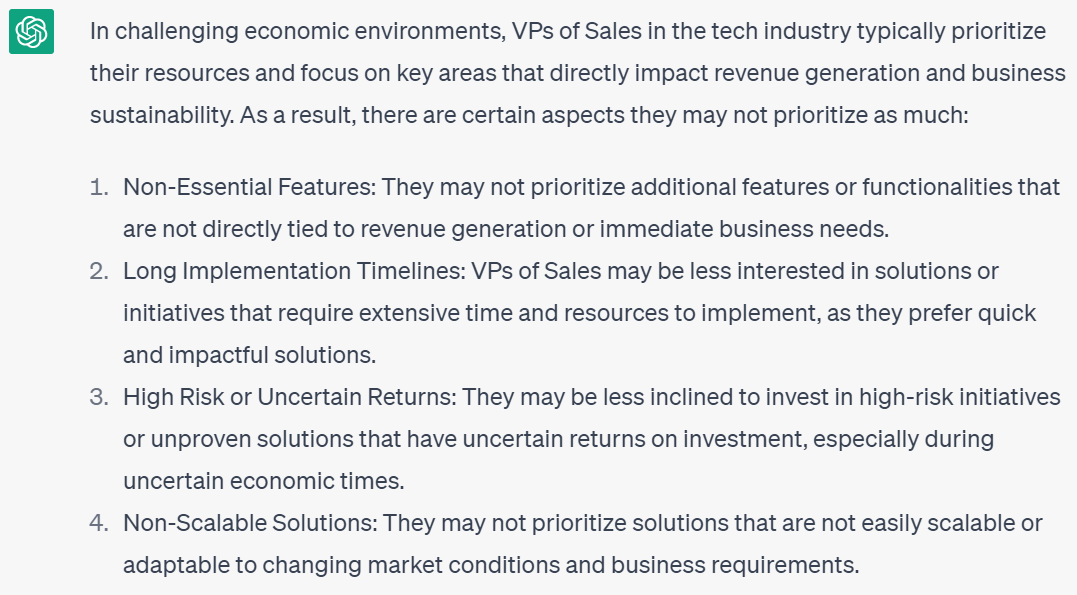
Prompt 3: "Based on these two questions, what are the top 2 value propositions that will cause people to buy because they generate the highest ROI?"
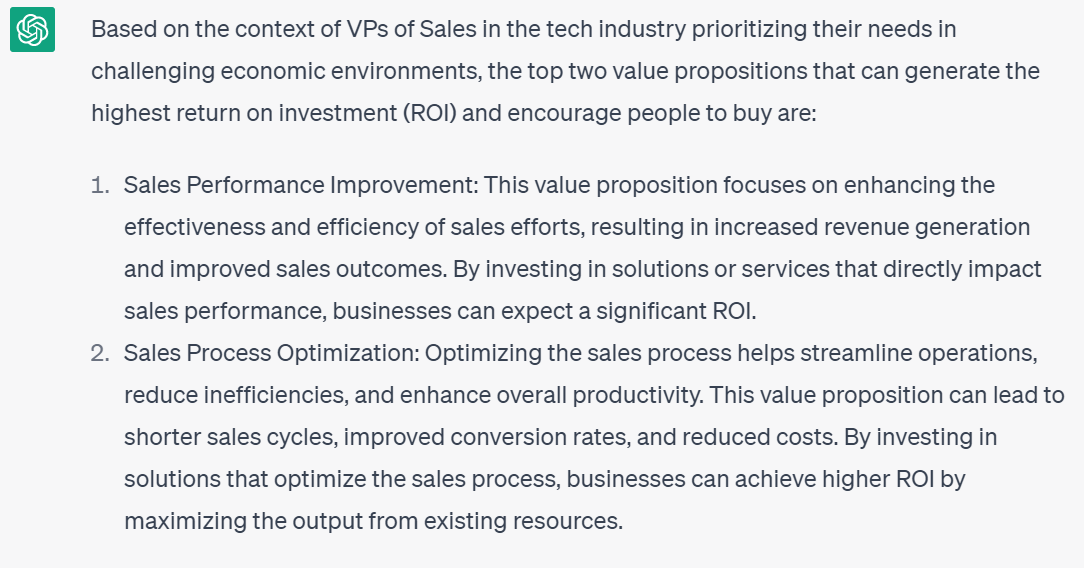
Two that I originally gave in the first prompt. So knowing this, I can focus on these two value propositions moving forward.
Prompt 4: "What are 4 questions I can ask that (VP of sales) to get them to see that we might be able to solve their top priorities that may make them realize they need the solution?"

The questions directly correlate with the outputs from prompt 3 highlighting that you should showcase how your solution can address their top priorities (the ones from the output of prompt 3), so I'd say this prompt is a success! It even offered an explanation as to why these were the right questions to ask.
Prompt 5: "How would I adjust this pitch for the (VP of sales) to get budget approval from a CFO who cares about costs most?"
With this prompt, we kind of shifted to consider another variable in closing the deal. The output started with;
"When pitching your solution to a VP of Sales with the aim of obtaining budget approval from a CFO who prioritizes costs, it's important to emphasize the cost-saving aspects and financial benefits of your offering. Here's how you can adjust the pitch:"
And then went on to list 6 different suggestions like; starting with a cost-saving proposition, quantifying ROI and financial impact, emphasizing scalability and cost-effectiveness, providing cost comparisons and competitive advantage, addressing implementation and ongoing costs, and offering a cost-benefit analysis.
Prompt 6: "What will their biggest objections probably be that I should add in the proposal to make them comfortable?"
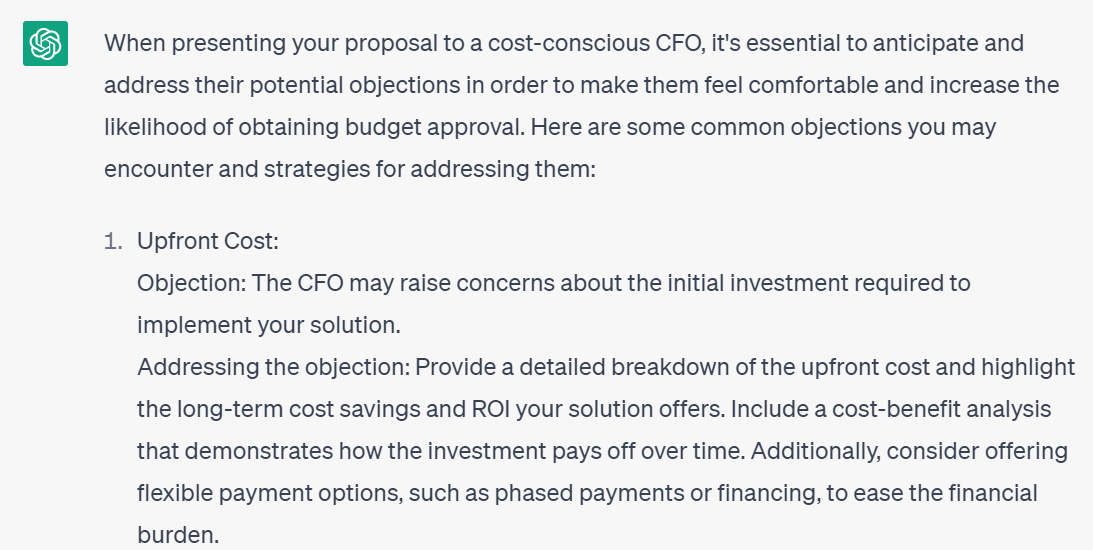
Not only did ChatGPT give me 5 important objections to have in mind, it preemptively listed how to address the objection as well. Seems like we are really on to something here.
And now, with this last prompt, we have the opportunity to really bring it all together;
Prompt 7: "Based on all of this, what would be the top 10 slides to include in a deck to pitch my services to address both use cases highlighting the top priorities and needs of the (VP of sales) and also to address the concerns of the (CFO)"
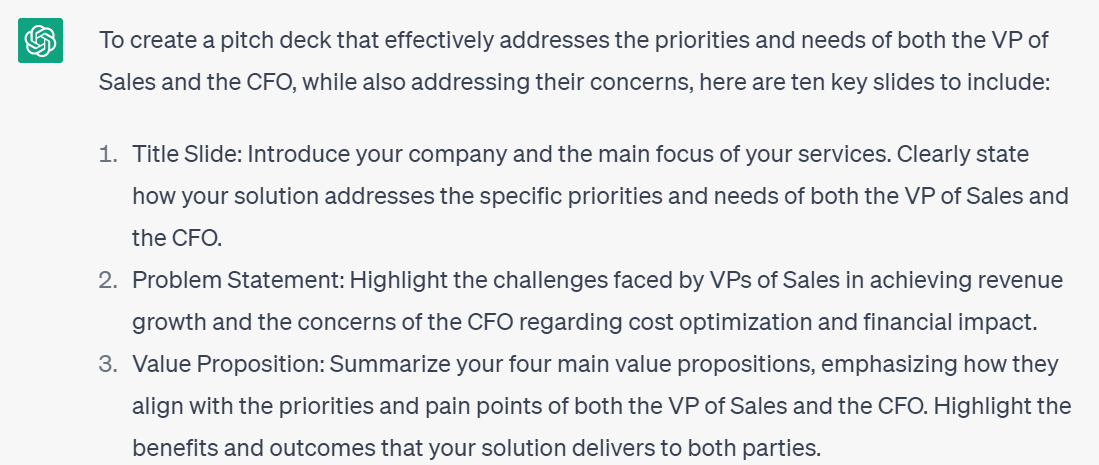
What I got was a great outline for a sales pitch directed at the VP of sales, also keeping in mind the CFO. It did loop in some of the suggestions it gave in the earlier prompts, but I was almost expecting it to prepare the slides for me. So, I followed up with another prompt asking ChatGPT to;
"Can you add in the challenges and value propositions that you gave above, and suggest text for slides 2 and 3?"
To which ChatGPT replied;
“Certainly! Here are the suggested texts for slides 2 and 3, incorporating the challenges and value propositions discussed earlier:”
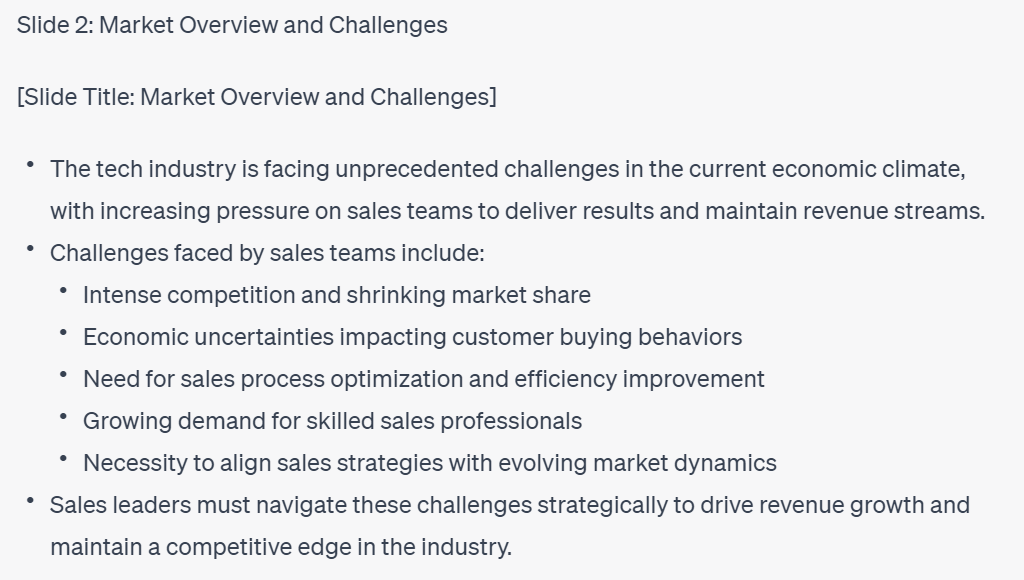
So, with this chain of prompts, and possibly even continuing on with more prompts, it seems to me a sales rep would be prepared and confident to walk into their sales pitch in considerably less time.
It's worth pointing out that we probably wouldn't have had the same success had we jumped to the last prompt from the beginning. In fact, then we would have been stuck with the outline, but none of the insight as to what the value propositions and challenges are. So in this example, breaking down the process into distinct prompts was the key to unlocking ChatGPT's full potential.
And regardless of whether this specific sequence of prompts is suitable for your sales team, or even your industry, you can turn your own set of steps into a ChatGPT prompt chain to ease your workflow or that of your team.
In the comments of Dunlap's LinkedIn post, Mike Macioci suggested adding a prompt to take into consideration client personality type which is a great example of ways that you can make the prompt series your own.
Selling with Emotions
And just as Macioci's comment suggests above, there are plenty of ways you can customize your own prompt series. The internet is full of one-off prompts for ChatGPT that could be useful for selling.
For example, as B2B sales trainer Josh Braun points out on LinkedIn, facts don't sell as well as emotions sell. To prove his point, he uses the example of these two statements; "A Porsche has 443 horsepower,” and “A Porsche is like your own portable amusement park,” the latter of the two more likely to put a smile on your face, and make you feel something, in turn, a better sales technique.
So he suggests using ChatGPT to write metaphors about your prospect’s problems;
“Write a metaphor in the form of a question about writing and executing SQL queries taking a long time to execute. Start with the words ever wish”
Something that can be easily added to your prompt sequence to embellish your sales pitch.
Conclusion
We've seen success in the examples above, but what about real-world results? Is ChatGPT giving quantifiable results to those in the sales industry? Teresha Aird, CMO of Offices.net says that "while it's difficult to attribute a specific dollar amount to ChatGPT's impact on our revenue, we've seen a significant increase in client engagement and satisfaction since adopting this technology. With ChatGPT's help, we've been able to convert more leads into sales, increase customer loyalty, and generate an increase in repeat business."
Given the current trajectory of sales technology, it's pretty clear that we'll likely see a surge in the use of generative AI tools in the sales industry. But as this LinkedIn user Thibaut Souyris puts it, "AI won't replace salespeople. Salespeople who use AI will replace salespeople who don't." So, it's definitely in the best interest of sales reps and sales leaders to learn how to use it either for themselves or their sales team.